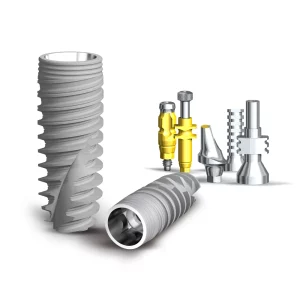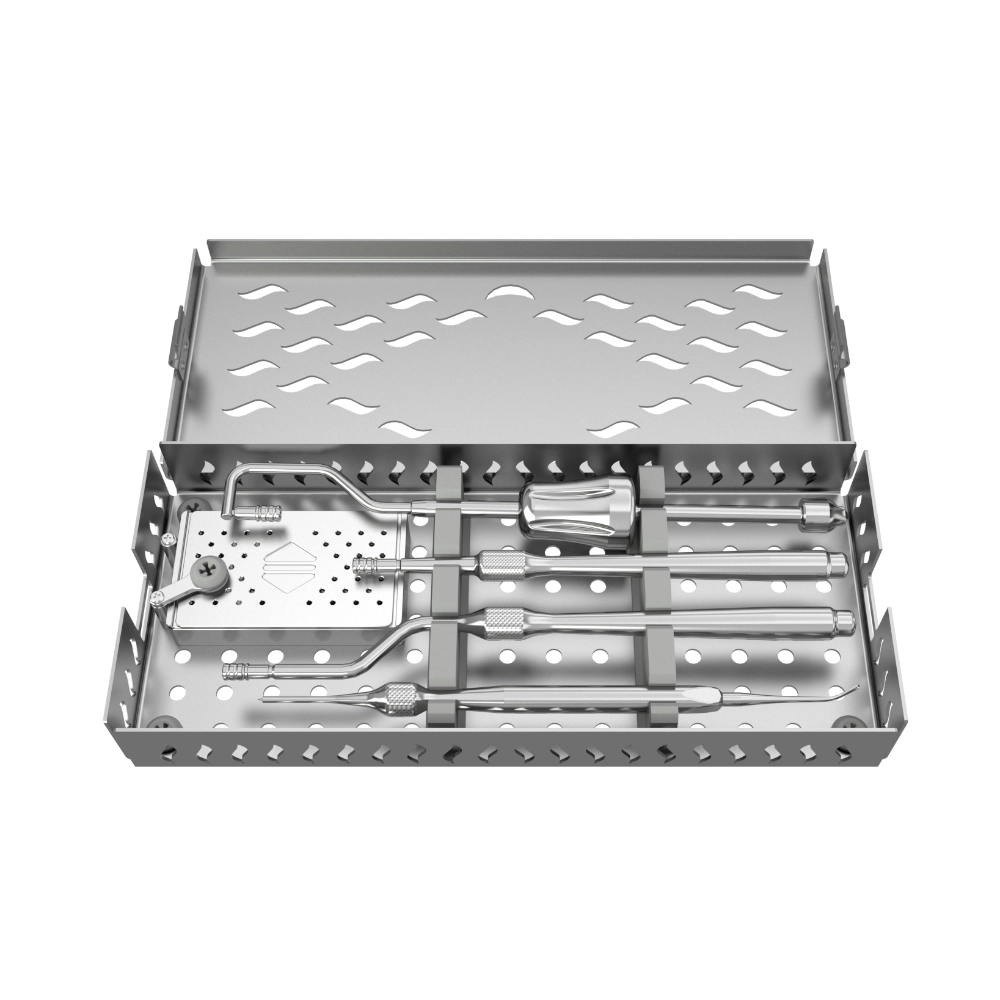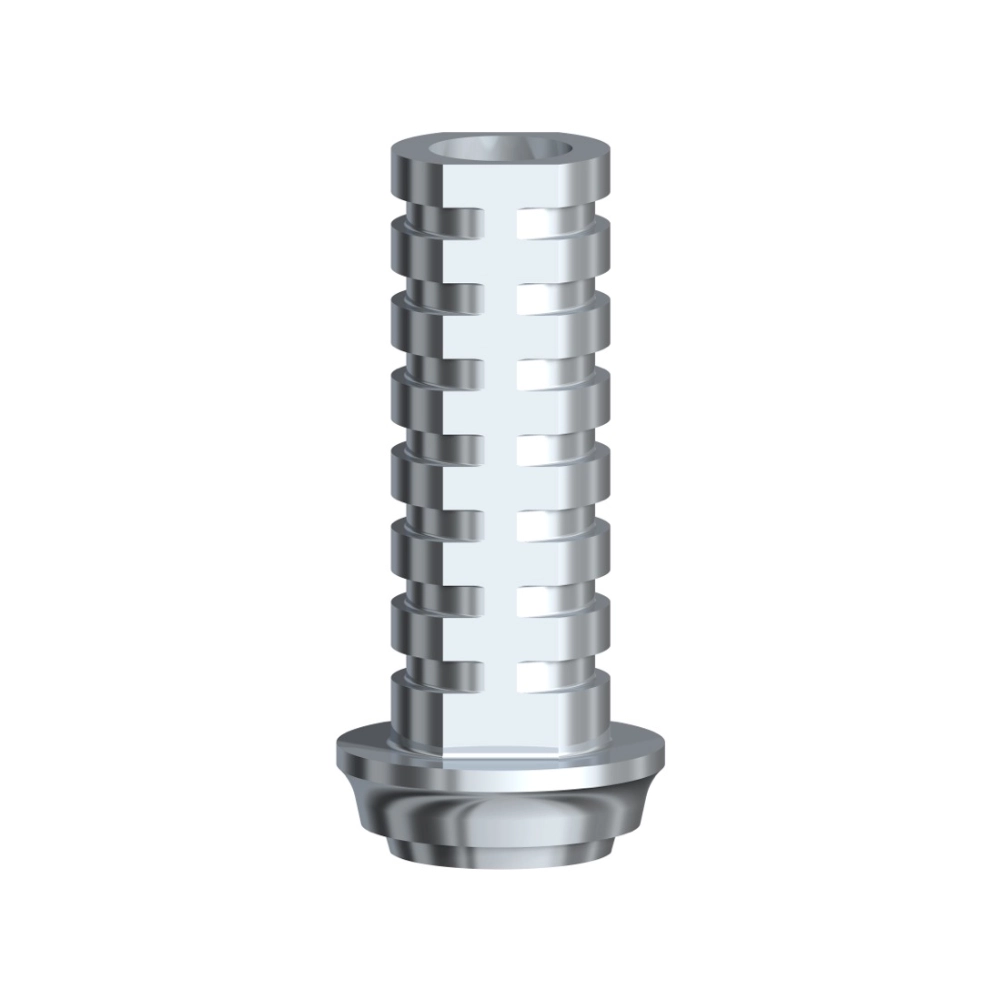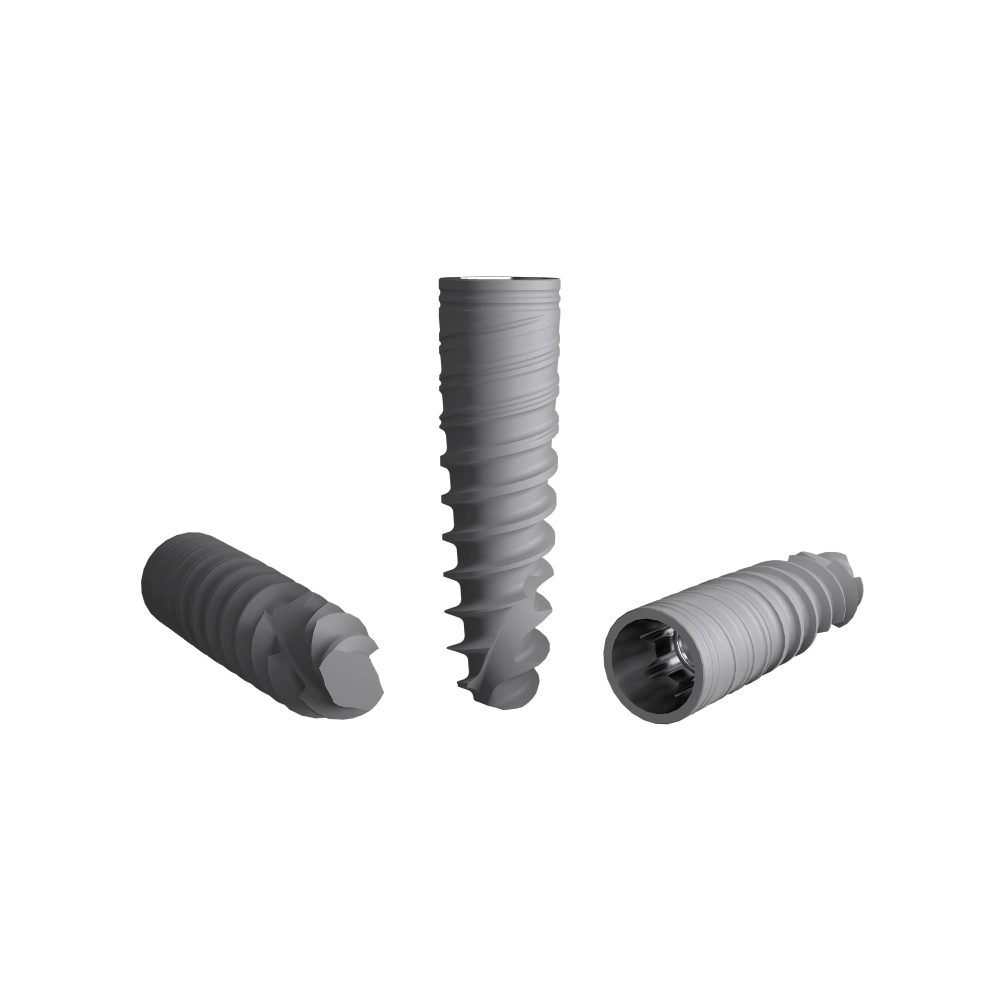
In today’s dental field, dental implants have become a revolutionary treatment option and the preferred solution for restoring both the function and aesthetics of missing teeth. Simply put, a dental implant involves surgically placing an artificial tooth root (usually made of titanium alloy) into the jawbone. Once it fuses with the surrounding bone tissue, a crown is placed on top, mimicking the structure and function of a natural tooth. This technology not only greatly enhances chewing efficiency and oral comfort but also significantly boosts personal confidence due to its realistic appearance. As a result, dental implants play a crucial role in modern dentistry.
However, despite the increasing maturity and high success rate of dental implant technology, there are still potential risks and complications, among which infection is particularly concerning. Peri-implantitis, failed osseointegration, and soft tissue infections are common post-surgical complications that can arise. These infections not only extend the treatment period and increase costs but, in severe cases, can threaten the stability of the implant, even leading to implant failure and the need for secondary surgical intervention. Therefore, infection-related issues cannot be overlooked, as they directly impact the long-term success of the implant and the patient’s quality of life.
In this context, early detection and proper treatment of dental implant-related infections are especially important. Timely diagnosis and intervention can effectively control the spread of infection, alleviate patient discomfort, and maximize the health of the implant, ensuring its long-term stability and success rate. This article will briefly explain the causes of dental implant infections, the reasons behind them, and how they can be treated.
What is a Dental Implant Infection?
Dental implant infection refers to the invasion of bacteria, viruses, or other microorganisms into the implant and surrounding tissues during the healing process after implant surgery or during the long-term use of the implant. This results in pathological changes such as localized tissue inflammation, redness, swelling, pain, and even pus formation. The infection may involve the soft tissues surrounding the implant (such as the gums) and/or the hard tissues (such as the alveolar bone). In severe cases, it can threaten the stability and long-term survival rate of the implant.
The specific types of dental implant infections include but are not limited to:
- Peri-implantitis: This is the most common form of dental implant infection, characterized by inflammation of the soft tissues around the implant. It may cause gum redness, swelling, bleeding, and recession. In severe cases, it may be accompanied by pus formation and bone tissue destruction.
- Implant osseointegration failure: Due to infection, poor healing between the implant and surrounding bone tissue may occur, preventing the implant from securely anchoring in the bone, thus affecting its support and longevity.
- Implant loosening or loss: Prolonged infection or untreated peri-implantitis can lead to implant loosening, which may eventually result in implant loss.
The occurrence of dental implant infections is associated with several factors, including poor oral hygiene habits, inadequate sterile procedures during surgery, compromised immune status of the patient, smoking habits, underlying conditions such as diabetes, and factors related to the implant material and design.
Causes of Dental Implant Infection
1. Poor Oral Hygiene Leading to Bacterial Accumulation
Oral hygiene is one of the key factors in the success of dental implants. If patients fail to maintain good oral hygiene habits after implant surgery, such as brushing regularly and using dental floss, bacteria can easily thrive in the mouth, forming plaque and tartar. These bacteria and their metabolic byproducts can invade the surrounding tissues of the implant, leading to infection. The gum line around the implant is especially prone to bacterial buildup and inflammation.
2. Poor Implantation Technique
The implantation process requires high precision and sterile techniques. If the dentist lacks adequate skills or fails to strictly follow aseptic protocols during the procedure, damage to the surrounding soft and hard tissues may occur, increasing the risk of infection. Additionally, factors like implant design, material selection, and the placement of the implant can affect its stability and resistance to infection.
3. Underlying Health Conditions
Certain underlying health conditions may increase the risk of dental implant infections. For example, patients with diabetes have higher blood sugar levels, which can impair wound healing and immune function, thus raising the infection risk. Similarly, individuals with blood disorders, immune system diseases, or those undergoing immunosuppressive treatments may have weakened defenses against infections, making them more susceptible to implant-related infections.
4. Smoking and Lifestyle Factors
Smoking is a significant risk factor for dental implant infections. Harmful substances in tobacco damage oral mucosa and periodontal tissues, weaken the body’s immune response, and increase the risk of infection. Smoking also affects blood circulation around the implant, delaying the healing process. Additionally, unhealthy lifestyle habits, such as lack of exercise and poor nutrition, can impact the overall health and immune function, further heightening the risk of infection.
Can a Dental Implant Get Infected Years Later?
Dental implant infection is a potential complication of the implant procedure, and its occurrence rate can vary depending on individual differences, surgical techniques, post-operative care, and the patient’s overall health. Epidemiological studies suggest that the incidence of dental implant infections generally fluctuates within a certain range, and specific data may differ depending on the research methods and sample sizes used. However, some statistics indicate that the incidence of peri-implantitis (a common type of dental implant infection) is approximately 22%, highlighting that dental implant infections are relatively common and should be given due attention by both patients and clinicians.
Risk Factors for Infection:
- Uncontrolled Diabetes: Patients with uncontrolled diabetes are at an increased risk of infection because high blood sugar levels can impair wound healing and immune function, making the body more susceptible to infections.
- Poor Oral Hygiene: Insufficient oral hygiene leads to the accumulation of bacteria and plaque, providing a breeding ground for infection. Without regular brushing, flossing, and professional cleanings, bacteria can easily invade the implant site, leading to infection.
- Smoking: Smoking is a major risk factor for dental implant infections. The harmful substances in tobacco can damage oral mucosa and periodontal tissues, reduce the body’s immune response, and impair blood circulation around the implant, delaying healing and increasing the risk of infection.
Other Contributing Factors:
- Improper Implant Placement: The positioning, angle, or depth of the dental implant during surgery can impact its healing and stability. If the implant is not placed correctly, it can affect its integration with surrounding tissues, leading to a higher likelihood of infection.
- Poor Post-Operative Care: Failure to follow proper post-operative care instructions, such as maintaining oral hygiene and avoiding irritants, can also contribute to infection. Proper care and regular check-ups are essential to ensuring the success of the implant and preventing infection.
Overall, while dental implant infection is a relatively common complication, its risk can be minimized through careful patient selection, proper surgical techniques, diligent post-operative care, and addressing specific health concerns.
Indications That Your Dental Implant Is Infected
It’s important to be mindful of any indications of infection if you have a dental implant. Preventing such problems requires early identification and treatment. The following are typical signs that your dental implant could be infected:
- Persistent Bad Breath: An infection around your implant may be the cause of persistent bad breath that doesn’t go away with brushing or flossing. This often signals the onset of an oral infection or bacterial accumulation.
- Abscess or Pus: An obvious indication of infection is the presence of pus around the implant. This may be followed by pain or swelling, which may need to be treated right away.
- Bleeding: An infection may be the cause of any bleeding you see around the implant, particularly after eating or brushing. It’s critical that your dentist examine this as soon as possible.
- Pain or Discomfort: Another warning sign is pain around the implant, especially while chewing or biting. Pain often indicates infection or inflammation in the surrounding tissue.
- Fever: Bacterial infections are often accompanied with fever. See a dentist right away if you have discomfort or pus surrounding the implant in addition to a fever.
- Red or Swollen Gums: An infection may be indicated by red, painful, or swollen gums around the implant. One of the most typical indicators that something is amiss is this.
- Loose Implant: It’s a major issue if your implant seems unsteady or loose. Long-term implant success depends on stability, and a loose implant may indicate infection or bone loss in the surrounding area.
It’s imperative that you visit your dentist right away if you have any of these symptoms. The likelihood of protecting your implant and averting more severe issues increases with the prompt detection and treatment of an infection. In order to cure the infection and guarantee the ongoing health of your implant, your dentist will assess the region and suggest a suitable course of action.
Do I Have to Take Antibiotics After a Tooth Implant?
Whether antibiotics are required after a dental implant procedure depends on various factors, including the patient’s health condition, the surgical process, post-operative care, and the dentist’s recommendations. Here’s a detailed explanation of the issue:
1. Purpose of Antibiotics After a Dental Implant
Dental implant surgery is a type of invasive procedure, and there is a risk of infection in the oral cavity post-surgery. The primary purpose of taking antibiotics is to prevent infection, ensuring smooth healing and long-term stability of the implant.
2. Factors to Consider When Deciding Whether to Take Antibiotics
- Patient’s Health Status: If a patient has immune system issues, diabetes, or other chronic conditions, they may be at higher risk of infection. In such cases, antibiotics may be prescribed to reduce this risk.
- Surgical Procedure: If the surgery is more extensive, the procedure takes longer, or if there are complications during surgery, the dentist may recommend antibiotics as a preventive measure to avoid infection.
- Post-operative Care: Proper oral hygiene and care after the surgery are crucial for preventing infections. If a patient is able to maintain good oral hygiene, they may not need additional antibiotics.
- Dentist’s Recommendations: Ultimately, whether antibiotics are necessary should be decided by the dentist, who will assess the patient’s specific situation and surgical procedure. The dentist will develop a personalized post-operative care plan, including whether antibiotics are needed.
3. Antibiotic Selection and Usage
- Types of Antibiotics: Common antibiotics used after dental implants include cephalosporins (e.g., cefalexin, cefazolin, cefuroxime), metronidazole, and clindamycin. The choice of antibiotic will depend on the patient’s specific condition and the dentist’s advice.
- Duration of Use: Antibiotics are usually prescribed to be taken both before and after surgery to ensure proper sterilization of the surgical area and prevent infection. The duration of use will be determined by the dentist.
- Dosage: Antibiotic dosage should be strictly followed according to the dentist’s instructions to avoid underuse or overdose.
4. Precautions
- Allergic Reactions: Before taking antibiotics, patients should inform their dentist if they have a history of drug allergies to avoid any allergic reactions.
- Drug Interactions: If the patient is taking other medications, they should inform the dentist to prevent any potential drug interactions.
- Follow the Doctor’s Orders: Patients should strictly follow the dentist’s instructions regarding antibiotics, avoiding self-medication or altering the prescribed treatment plan.
Whether antibiotics are needed after a dental implant depends on the patient’s individual situation and the dentist’s professional judgment. If prescribed, patients should follow the dentist’s instructions carefully regarding the dosage and duration of use, and report any unusual symptoms or discomfort during the recovery process.
How to Treat a Dental Implant Infection?
The treatment of dental implant infections primarily involves early detection and diagnosis, non-surgical treatments, surgical treatments, and follow-up care. Below is a detailed explanation of these treatment methods:
1. Early Detection and Diagnosis
- Visual Examination:
The dentist will perform a visual inspection of the patient’s mouth, looking for signs of infection around the implant, such as redness, swelling, bleeding, or pus. - Radiographic Examination:
X-rays or CT scans may be used to check for bone loss around the implant and to assess the extent and severity of the infection.
2. Non-Surgical Treatment
- Cleaning and Debridement of the Affected Area:
The dentist will use specialized tools to thoroughly clean and debride the infected area, removing the source of infection and any necrotic tissue. - Use of Antibacterial Solutions or Local Antibiotics:
After cleaning and debridement, the dentist may recommend the use of antibacterial mouthwashes or local application of antibiotic medications to kill or inhibit bacterial growth. - Improvement of Oral Hygiene Habits:
Patients are advised to maintain good oral hygiene at home, including regular brushing, flossing, and using mouthwash, to reduce bacterial growth and prevent further infections.
3. Surgical Treatment
If the infection is severe or cannot be controlled with non-surgical treatments, surgical intervention may be necessary. Surgical treatment methods include:
- Surgical Removal of Infected Tissue:
The dentist may perform surgery to open the infected area, completely remove the infected tissue, and carry out necessary cleaning and suturing. - Bone Grafting:
If the infection has caused significant bone loss, a bone grafting procedure may be required to support and stabilize the implant.
4. Follow-up Care
- Follow-up Monitoring:
After treatment, patients need to visit their dentist regularly for check-ups and assessments to monitor the health of the implant and the recovery from the infection. - Continued Use of Antibiotics:
Depending on the dentist’s recommendations, patients may need to continue using antibiotics after surgery to strengthen the treatment effect and prevent recurrence. - Maintaining Oral Hygiene:
Patients should continue to follow good oral hygiene practices to prevent future infections.
The treatment for dental implant infections should be tailored to the patient’s specific condition and the severity of the infection. Early detection and diagnosis are critical, while non-surgical and surgical treatments are common methods of intervention. Follow-up care is essential to ensure the effectiveness of the treatment and to prevent relapse. During the treatment process, patients should actively cooperate with the dentist’s recommendations and maintain good oral hygiene.
Can a Dental Implant Get Infected?
Dental implants can indeed become infected. Although dental implants are carefully designed and manufactured, and strict sterile procedures are followed during surgery, they are still not entirely immune to infection. This is primarily because the mouth is a bacteria-rich environment, and implants, being foreign objects in the mouth, can easily become breeding grounds for bacteria.
To prevent dental implant infections, patients can take the following measures:
1. Maintain Cleanliness of the Implant Area:
Good oral hygiene is key to preventing infections around implants. Patients should brush their teeth regularly, use dental floss or interdental brushes to clean around the implant area, and rinse their mouth after meals. This helps remove food particles and bacteria, reducing the risk of infection.
2. Regular Dental Visits:
Regular professional dental check-ups and cleanings are essential for maintaining the health of the implant. Dentists can identify and address any potential signs of infection early, ensuring the long-term stability of the implant.
3. Ensure Proper Bone Integration:
Dental implants require good bone integration to remain stable. Therefore, patients should follow the dentist’s advice, avoid putting excessive pressure on the implant area, and refrain from engaging in intense physical activities that could disrupt the bone healing process.
Signs of Infection in Dental Implants
If patients experience any of the following symptoms, it may indicate an infection, and they should seek professional treatment immediately:
- Pain: Persistent pain around the implant could be an early symptom of infection. Patients should closely monitor the intensity and duration of the pain and promptly inform their dentist.
- Swelling: Swelling around the implant may indicate inflammation or infection. It is often accompanied by redness, heat, and tenderness.
- Implant Mobility: If the implant becomes loose or moves, it could be due to bone loss caused by infection. Immediate medical attention is needed to prevent further damage.
While dental implants can restore the function and appearance of teeth, patients still need to take proactive steps to reduce the risk of infection. If any signs of infection appear, patients should seek prompt medical attention for timely and effective treatment.
Conclusion
Dental implants, as a significant advancement in modern dental medicine, offer patients an effective means of restoring both the function and aesthetics of their teeth. However, it is crucial to understand that dental implants are not entirely immune to the risk of infection. Therefore, the importance of identifying and treating dental implant infections cannot be overstated.
To ensure the success of the implant and the overall oral health of the patient, prevention, early intervention, and professional care are essential. Prevention starts with the patient, and by maintaining good oral hygiene, regularly cleaning the implant area, and following the dentist’s professional advice, the risk of infection can be effectively reduced. Regular dental check-ups and cleanings are also key measures in preventing implant infections.
If patients experience symptoms such as pain, swelling, or implant mobility, these should be considered as urgent signals to seek professional help immediately. Early intervention not only effectively controls the infection and prevents further deterioration, but it also maximizes the protection of both the implant and the surrounding tissues.
We encourage all readers to consult their dentist without hesitation if they suspect their dental implant may be infected. Dentists will use their expertise and experience to make an accurate diagnosis and provide appropriate treatment to ensure the patient’s oral health and the long-term stability of the implant.
FAQ
1. What are the most common signs of dental implant infection?
Answer: The most common signs of dental implant infection include pain or discomfort around the implant area, swollen or visibly red gum tissue, bleeding gums when brushing or eating, pus or abscess formation around the implant, and persistent bad breath or an unpleasant taste in the mouth. If any of these symptoms occur, it’s important to contact your dentist immediately.
2. How can I prevent infection after getting a dental implant?
Answer: To effectively prevent infection after getting a dental implant, you should maintain good oral hygiene, including regular brushing, using dental floss to clean between teeth, and avoiding smoking. It is also essential to strictly follow all post-surgery care instructions, such as avoiding excessive brushing force or using irritating mouthwashes. Additionally, regular follow-up appointments with your dentist are critical to monitor the healing of the implant and provide necessary guidance.
3. What happens if a dental implant gets infected?
Answer: If a dental implant becomes infected and is not treated promptly, it can lead to severe consequences such as worsening gum disease, accelerated bone loss, and implant failure. Infection can also cause intense pain, swelling, and, in some cases, lead to implant looseness or the need for removal. Early detection and treatment are essential to prevent these adverse outcomes.
4. Can I treat an infected dental implant at home?
Answer: While maintaining good oral hygiene is essential for preventing and managing dental implant infections, it is not recommended to treat an infected dental implant at home. You should seek professional consultation with your dentist for proper diagnosis and treatment. Treatment may involve antibiotics, professional cleaning, or surgical intervention.
5. How long does it take for a dental implant to heal fully?
Answer: The full healing time for a dental implant varies depending on the individual but generally takes 3 to 6 months. During this period, the implant fuses with the bone (osseointegration). However, the soft tissue healing around the implant may take a few weeks to several months, depending on the individual’s healing response and capacity.
6. What are the risks of dental implants?
Answer: Dental implant surgery carries certain risks, including infection, implant failure, nerve damage, gum recession, and complications due to underlying health conditions such as diabetes or immune system issues. It is important to have a thorough discussion with your dentist before the procedure to understand and assess these risks.
7. Can an infected dental implant be saved?
Answer: Yes, an infected dental implant can often be saved with timely intervention and treatment. Treatment may involve cleaning the implant area, using antibiotics to treat the infection, or performing minor surgery to remove the infected tissue. In more severe cases, if the infection cannot be controlled or the implant is severely damaged, the implant may need to be removed and replaced after the infection heals.
8. What are the main causes of dental implant infection?
Answer: The main causes of dental implant infection include poor oral hygiene, smoking habits, underlying health conditions like diabetes, improper placement of the implant, or contamination during surgery due to inadequate sterile techniques. To ensure the implant site remains clean and reduce the risk of infection, it is essential to follow all post-surgery instructions and maintain good oral hygiene habits.
9. Can dental implants cause sinus infections?
Answer: In rare cases, dental implants placed in the upper jaw may protrude into or near the sinus cavity, which can lead to a sinus infection. This may cause symptoms such as sinus congestion, facial pain, post-nasal drip, and nasal blockage. If this occurs, you should consult your dentist immediately for prompt treatment.
10. How can I improve my chances of a successful dental implant surgery?
Answer: To improve the chances of a successful dental implant surgery, you need to have a thorough consultation with your dentist to determine if you are a suitable candidate. Before and after the procedure, it is essential to maintain good oral hygiene and strictly follow all post-surgery instructions. Additionally, avoiding smoking and attending all follow-up appointments to monitor the healing of the implant are key factors in improving the surgery’s success rate.
11.Why should dental professionals use the titanium brush for implant cleaning?
- Precision Cleaning
- Efficiency
- Innovative Design
- Patient Comfort
DentalMaster titanium brush is a valuable tool for ensuring thorough cleaning of implants while minimizing risks and improving patient outcomes.








